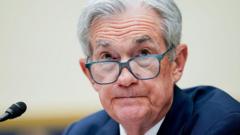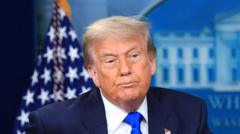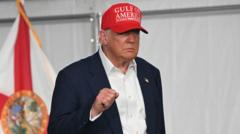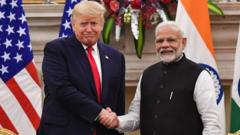*In a groundbreaking announcement, President Trump reveals plans for a revised trade agreement with Vietnam, signifying a strategic pivot in international commerce that could reshape the global market landscape.*
**Trump's Trade Deal with Vietnam: A New Economic Era?**

**Trump's Trade Deal with Vietnam: A New Economic Era?**
*The preliminary agreement aims to reshape tariffs and trade flows between the U.S. and Vietnam amid tensions with China.*
In a major announcement on Wednesday, President Trump declared that the United States has reached a preliminary trade agreement with Vietnam, marking a significant shift in the economic ties between the two nations. This deal comes after a series of tariff escalations under the Trump administration, which prompted many manufacturers to consider relocating their operations from China to other countries, including Vietnam.
The preliminary trade pact aims to reduce some of the stringent tariffs imposed on Vietnamese goods in exchange for Vietnam's commitment to open up its markets wider to American exports. "It will be a Great Deal of Cooperation between our two Countries," Trump declared in a post on Truth Social, emphasizing the cooperative nature of the deal.
One of the core components of the agreement includes a 20 percent tariff on all imports from Vietnam, along with a more stringent 40 percent tariff specifically targeting products that may be transshipped from China. This means that goods shipped to the U.S. from Vietnam, which may have originally been produced in China, would face these heightened tariffs.
The deal seeks to address longstanding concerns that Vietnam has served as a conduit for Chinese products to circumvent U.S. trade barriers. Howard Lutnick, the Commerce Secretary, reiterated in a post on X that products exported by Vietnam containing significant Chinese components would face hefty tariffs, essentially targeting the indirect impact of Chinese manufacturing on U.S. imports.
As this agreement takes shape, uncertainty remains over which specific products would fall under the new tariff structure. It has been indicated that items manufactured in Vietnam with minimal Chinese parts could see lower tariffs, while those heavily reliant on Chinese materials would incur additional costs.
Vietnam, eager to integrate more deeply into global supply chains, is watching closely as this trade landscape shifts amidst a backdrop of rising tensions with China. As such, the implications of this agreement could span beyond bilateral trade into broader geopolitical dynamics affecting multiple countries involved in international trade.
The preliminary trade pact aims to reduce some of the stringent tariffs imposed on Vietnamese goods in exchange for Vietnam's commitment to open up its markets wider to American exports. "It will be a Great Deal of Cooperation between our two Countries," Trump declared in a post on Truth Social, emphasizing the cooperative nature of the deal.
One of the core components of the agreement includes a 20 percent tariff on all imports from Vietnam, along with a more stringent 40 percent tariff specifically targeting products that may be transshipped from China. This means that goods shipped to the U.S. from Vietnam, which may have originally been produced in China, would face these heightened tariffs.
The deal seeks to address longstanding concerns that Vietnam has served as a conduit for Chinese products to circumvent U.S. trade barriers. Howard Lutnick, the Commerce Secretary, reiterated in a post on X that products exported by Vietnam containing significant Chinese components would face hefty tariffs, essentially targeting the indirect impact of Chinese manufacturing on U.S. imports.
As this agreement takes shape, uncertainty remains over which specific products would fall under the new tariff structure. It has been indicated that items manufactured in Vietnam with minimal Chinese parts could see lower tariffs, while those heavily reliant on Chinese materials would incur additional costs.
Vietnam, eager to integrate more deeply into global supply chains, is watching closely as this trade landscape shifts amidst a backdrop of rising tensions with China. As such, the implications of this agreement could span beyond bilateral trade into broader geopolitical dynamics affecting multiple countries involved in international trade.




















